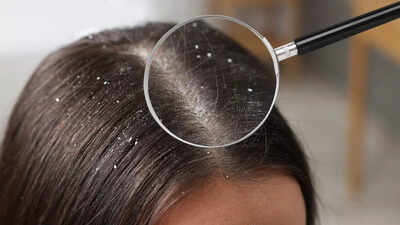Health
Tackle Sticky Oily Dandruff: Causes, Treatments, and Care

Experiencing a persistent greasy, itchy scalp after washing your hair? You may be dealing with sticky oily dandruff, a condition that is often misdiagnosed. Unlike typical dry dandruff, this type adheres to the scalp, forming thick, yellowish patches that resist conventional shampoo treatments.
Research published in Medical Mycology highlights that sticky dandruff arises not from poor hygiene, but rather from an overgrowth of Malassezia yeast and excess scalp oil. This unique biological phenomenon complicates the issue, rendering standard hair care routines ineffective. Understanding its causes and management can significantly improve scalp health.
Understanding the Causes of Sticky Oily Dandruff
Sticky oily dandruff is a result of an imbalance in the scalp’s ecosystem. When the scalp produces excessive oil, it creates a breeding ground for Malassezia yeast, which thrives in oily environments. This yeast metabolizes sebum into fatty acids, leading to scalp irritation and inflammation. As a consequence, individuals may experience intense itchiness and visible buildup.
Lifestyle factors such as stress, hormonal shifts, and dietary choices can further exacerbate the condition. Stress, in particular, is known to elevate oil production, making the scalp more susceptible to inflammation and chronic issues.
Why Traditional Shampoo Treatments Fall Short
Many people find themselves frustrated after frequent shampooing, only to notice that the greasy patches persist. Most commercial shampoos are formulated to remove surface dirt and oil, not to address the underlying issue of yeast overgrowth or sebum imbalance. Overwashing can inadvertently strip the scalp of its natural oils, triggering a compensatory increase in oil production. This creates a frustrating cycle where the scalp never feels truly clean.
To effectively combat sticky oily dandruff, specialized medicated shampoos are necessary. Products containing active ingredients such as ketoconazole, selenium sulfide, and zinc pyrithione are designed to reduce the population of Malassezia yeast. Initially, it is advisable to use these treatments 2–3 times a week, gradually tapering off as symptoms improve.
Identifying Sticky Oily Dandruff Symptoms
Recognizing the symptoms of sticky oily dandruff is crucial for effective management. Unlike dry dandruff, which produces light, flaky particles, sticky dandruff manifests as thicker, greasier flakes that cling to the scalp. Individuals may notice a heavy, waxy buildup at the roots, leading to itchiness and limp hair. An unpleasant sour or musty odour may also accompany the buildup due to the combination of oil and yeast.
If you find your scalp feeling greasy only hours after washing, this could be a sign of sticky oily dandruff.
Effective Management Strategies
Managing sticky oily dandruff involves a multifaceted approach that includes targeted treatments, lifestyle modifications, and consistent care. Here are some strategies to consider:
– **Use antifungal shampoos**: Choose shampoos with ingredients like ketoconazole, selenium sulfide, or zinc pyrithione. These help control yeast growth and may be used 2–3 times weekly initially.
– **Avoid overwashing**: Limit washing to 2–3 times per week to maintain a healthy balance of natural scalp oils. Overwashing can lead to increased oil production.
– **Gentle scalp exfoliation**: Incorporate a soft brush or exfoliating shampoo into your routine. This can help remove sticky flakes without irritating the scalp.
– **Moisturise and repair**: Lightweight scalp oils or treatments containing ceramides can help strengthen the scalp’s barrier, reducing irritation and flaking.
– **Dietary support**: Focus on a diet rich in antioxidants, omega-3 fatty acids, and B vitamins. Reducing processed or greasy foods can also contribute to better scalp health.
– **Manage stress**: Implement stress-reducing activities such as mindfulness exercises, regular physical activity, and sufficient sleep to mitigate flare-ups.
– **Consult a dermatologist**: If symptoms persist, it may be necessary to seek professional advice to rule out conditions such as seborrheic dermatitis, which may require prescription treatments.
Sticky oily dandruff is not merely a hygiene issue; it stems from a complex interplay of biological factors, including excess oil and yeast overgrowth. While traditional shampoos may only address surface oil, understanding the underlying causes and implementing targeted treatments can significantly improve scalp health and comfort. With proper management, individuals can restore their scalp to a healthier state, reducing flaking and enjoying hair that feels fresh and clean.
Disclaimer: This article is for general informational purposes only and is not a substitute for professional medical advice, diagnosis, or treatment. Always consult a qualified healthcare provider for any medical condition or lifestyle change.
-

 World4 months ago
World4 months agoSBI Announces QIP Floor Price at ₹811.05 Per Share
-

 Lifestyle4 months ago
Lifestyle4 months agoCept Unveils ₹3.1 Crore Urban Mobility Plan for Sustainable Growth
-

 Science3 months ago
Science3 months agoNew Blood Group Discovered in South Indian Woman at Rotary Centre
-

 World4 months ago
World4 months agoTorrential Rains Cause Flash Flooding in New York and New Jersey
-

 Sports3 months ago
Sports3 months agoBroad Advocates for Bowling Change Ahead of Final Test Against India
-

 Top Stories4 months ago
Top Stories4 months agoKonkani Cultural Organisation to Host Pearl Jubilee in Abu Dhabi
-

 Science4 months ago
Science4 months agoNothing Headphone 1 Review: A Bold Contender in Audio Design
-

 Top Stories4 months ago
Top Stories4 months agoAir India Crash Investigation Highlights Boeing Fuel Switch Concerns
-

 Sports3 months ago
Sports3 months agoCristian Totti Retires at 19: Pressure of Fame Takes Toll
-

 Business4 months ago
Business4 months agoIndian Stock Market Rebounds: Sensex and Nifty Rise After Four-Day Decline
-

 Politics4 months ago
Politics4 months agoAbandoned Doberman Finds New Home After Journey to Prague
-

 Top Stories4 months ago
Top Stories4 months agoPatna Bank Manager Abhishek Varun Found Dead in Well









